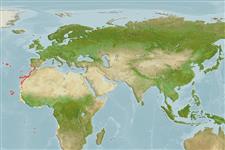>
Anguilliformes (Eels and morays) >
Muraenidae (Moray eels) > Muraeninae
Etymology: Enchelycore: Greek, enchelys, = eel + Greek, kore = pupil (Ref. 45335).
More on author: Lowe.
Environment: milieu / climate zone / djupintervall / distribution range
Ekologi
marina revassocierade; djupintervall 3 - 60 m (Ref. 58047). Subtropical; 40°N - 17°S, 32°W - 35°E
Eastern Atlantic: Azores, Madeira, Canary, Cape Verde, Ascension and St. Helena Islands including record from the Mediterranean coast of Israel (Ref. 3256), Greece (Ref. 43448) and Cyprus (Ref. 95695).
Size / Vikt / Age
Könsmognad: Lm ? range ? - ? cm
Max length : 120 cm TL hane/ej könsbestämd; (Ref. 5288)
Short description
Bestämningsnycklar | Morfologi | Morfometri
Occasional among rocks and rubble to depths of at least 10 m. They stay concealed among rocks, waiting for prey to come along. Are active predators which feed on crustaceans and fish (Ref. 5377). Possibly consumed in subsistence fisheries (Ref. 3254).
Life cycle and mating behavior
Könsmognad | Reproduktion | Lek | Ägg | Fecundity | Larver
Smith, D.G., 2012. A checklist of the moray eels of the world (Teleostei: Anguilliformes: Muraenidae). Zootaxa 3474:1-64. (Ref. 92337)
IUCN Red List Status (Ref. 130435: Version 2025-1)
Threat to humans
Harmless
Human uses
Fiskeri: husbehovsfiske
Verktyg
Special reports
Download XML
Internet-källor
Estimates based on models
Preferred temperature (Ref.
123201): 18.4 - 20.1, mean 19.8 °C (based on 14 cells).
Phylogenetic diversity index (Ref.
82804): PD
50 = 0.5001 [Uniqueness, from 0.5 = low to 2.0 = high].
Bayesian length-weight: a=0.00049 (0.00024 - 0.00099), b=3.26 (3.10 - 3.42), in cm total length, based on LWR estimates for this (Sub)family-body shape (Ref.
93245).
Trofisk nivå (Ref.
69278): 4.0 ±0.67 se; based on food items.
Resiliens (Ref.
120179): Mycket låg, lägsta populationsfördubblingstid mer än 14 år (Preliminary K or Fecundity.).
Fishing Vulnerability (Ref.
59153): High to very high vulnerability (72 of 100).
🛈
Nutrients (Ref.
124155): Calcium = 43 [26, 85] mg/100g; Iron = 0.798 [0.453, 1.327] mg/100g; Protein = 18.7 [16.6, 21.2] %; Omega3 = 0.248 [0.111, 0.634] g/100g; Selenium = 35.8 [18.4, 77.2] μg/100g; VitaminA = 8.77 [2.53, 31.31] μg/100g; Zinc = 0.572 [0.422, 0.812] mg/100g (wet weight);
